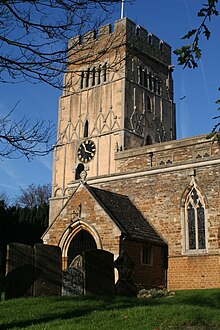
Anglo-Saxon architecture was a period in the history of architecture in England from the mid-5th century until the Norman Conquest of 1066. Anglo-Saxon secular buildings in Britain were generally simple, constructed mainly using timber with thatch for roofing. No universally accepted example survives above ground. Generally preferring not to settle within the old Roman cities, the Anglo-Saxons built small towns near their centres of agriculture, at fords in rivers or sited to serve as ports. In each town, a main hall was in the centre, provided with a central hearth.[1]
There are many remains of Anglo-Saxon church architecture. At least fifty churches are of Anglo-Saxon origin with major Anglo-Saxon architectural features, with many more claiming to be, although in some cases the Anglo-Saxon part is small and much-altered. It is often impossible to reliably distinguish between pre- and post-Conquest 11th century work in buildings where most parts are later additions or alterations. The round-tower church and tower-nave church are distinctive Anglo-Saxon types. All surviving churches, except one timber church, are built of stone or brick, and in some cases show evidence of re-used Roman work.
The architectural character of Anglo-Saxon ecclesiastical buildings range from Celtic influenced architecture in the early period; Early Christian basilica influenced architecture; and in the later Anglo-Saxon period, an architecture characterised by pilaster-strips, blank arcading, baluster shafts and triangular headed openings. In the last decades of the Anglo-Saxon kingdoms, a more general Romanesque style was introduced from the continent, as in the now built-over additions to Westminster Abbey made from 1050 onwards, already influenced by Norman style. In recent decades, architectural historians have become less confident that all undocumented minor "Romanesque" features post-date the Norman Conquest. Although once common, it has been incorrect for several decades to use the plain term "Saxon" for anything Anglo-Saxon that is later than the initial period of settlement in Britain.